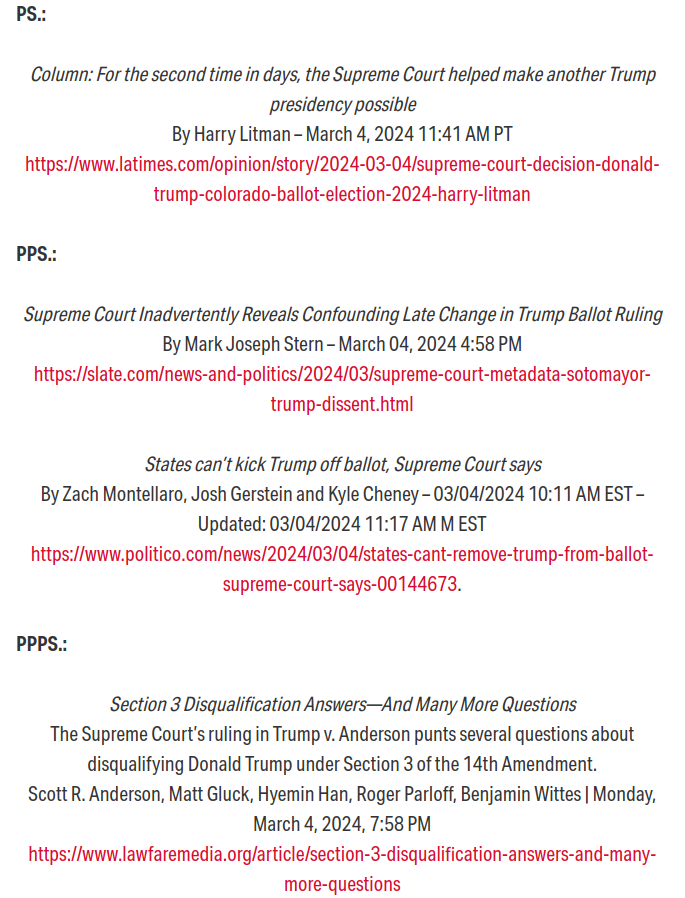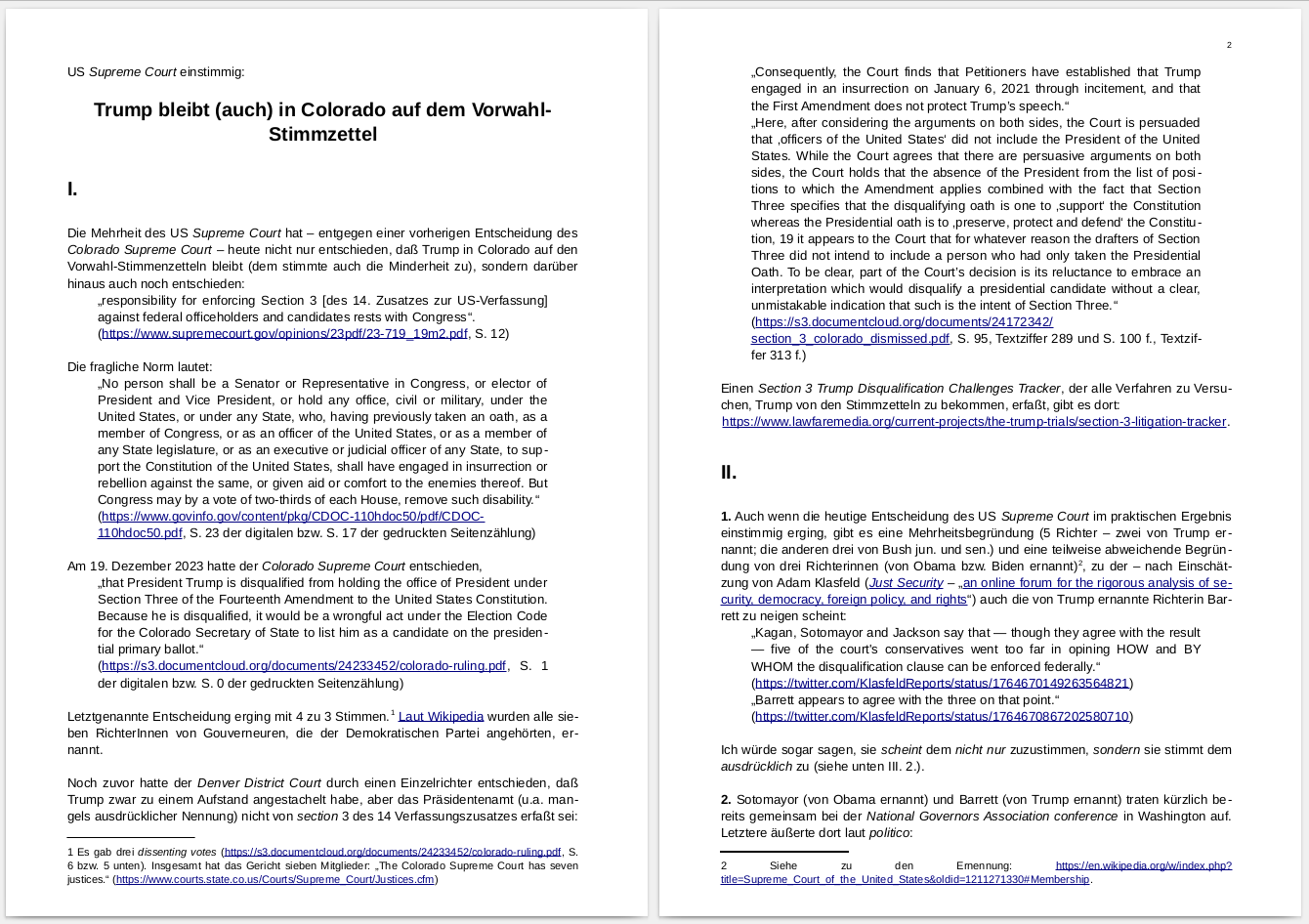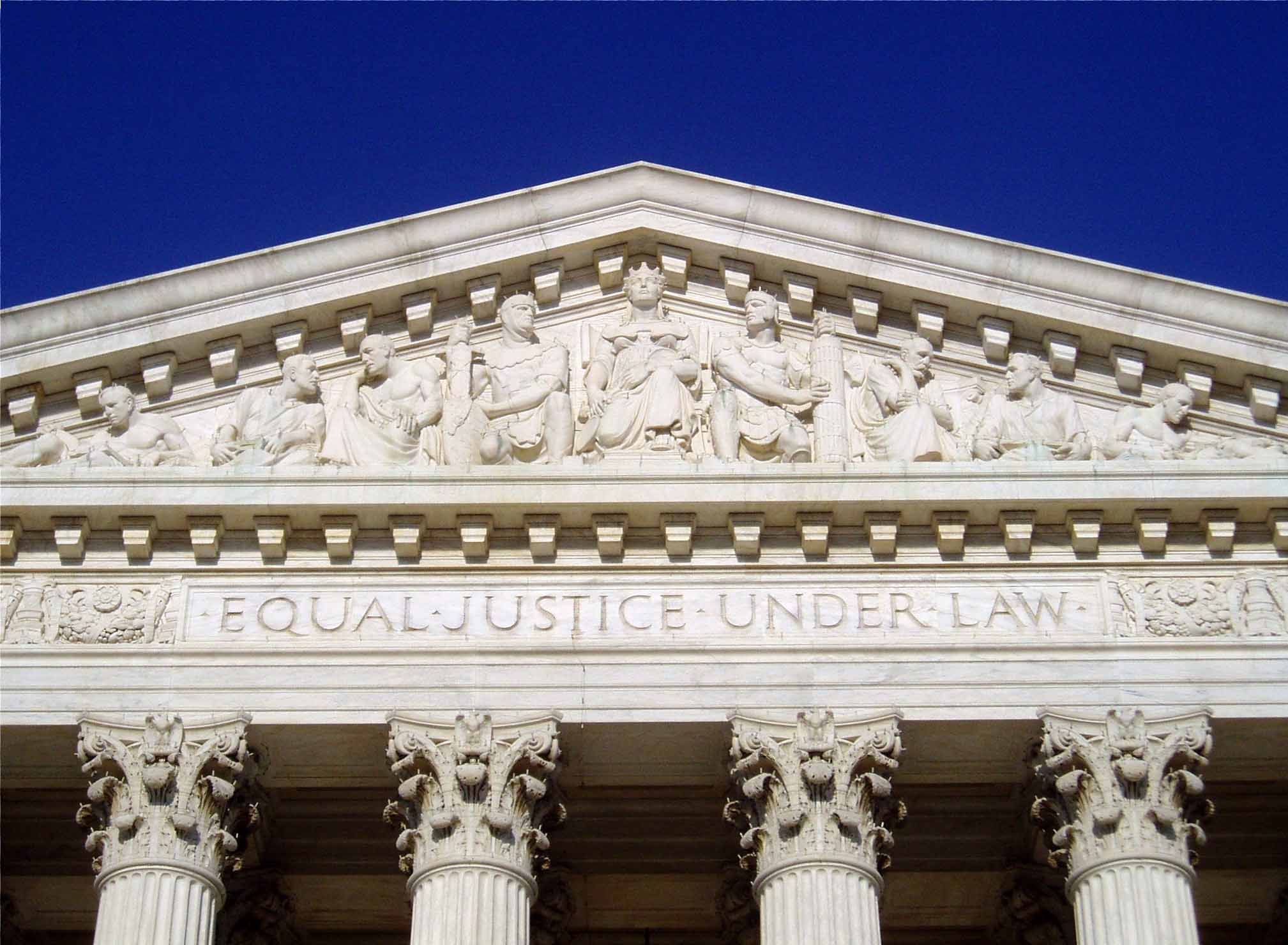I.
Die Mehrheit des US Supreme Court hat – entgegen einer vorherigen Entscheidung des Colorado Supreme Court – heute nicht nur entschieden, daß Trump in Colorado auf den Vorwahl-Stimmenzetteln bleibt (dem stimmte auch die Minderheit zu), sondern darüber hinaus auch noch entschieden:
„responsibility for enforcing Section 3 [des 14. Zusatzes zur US-Verfassung] against federal officeholders and candidates rests with Congress“.
(https://www.supremecourt.gov/opinions/23pdf/23-719_19m2.pdf, S. 12)
Die fragliche Norm lautet:
„No person shall be a Senator or Representative in Congress, or elector of President and Vice President, or hold any office, civil or military, under the United States, or under any State, who, having previously taken an oath, as a member of Congress, or as an officer of the United States, or as a member of any State legislature, or as an executive or judicial officer of any State, to support the Constitution of the United States, shall have engaged in insurrection or rebellion against the same, or given aid or comfort to the enemies thereof. But Congress may by a vote of two-thirds of each House, remove such disability.“
(https://www.govinfo.gov/content/pkg/CDOC-110hdoc50/pdf/CDOC-110hdoc50.pdf, S. 23 der digitalen bzw. S. 17 der gedruckten Seitenzählung)
Am 19. Dezember 2023 hatte der Colorado Supreme Court entschieden,
„that President Trump is disqualified from holding the office of President under Section Three of the Fourteenth Amendment to the United States Constitution. Because he is disqualified, it would be a wrongful act under the Election Code for the Colorado Secretary of State to list him as a candidate on the presidential primary ballot.“
(https://s3.documentcloud.org/documents/24233452/colorado-ruling.pdf, S. 1 der digitalen bzw. S. 0 der gedruckten Seitenzählung)
Letztgenannte Entscheidung erging mit 4 zu 3 Stimmen.1 Laut Wikipedia wurden alle sieben RichterInnen von Gouverneuren, die der Demokratischen Partei angehörten, ernannt.
Noch zuvor hatte der Denver District Court durch einen Einzelrichter entschieden, daß Trump zwar zu einem Aufstand angestachelt habe, aber das Präsidentenamt (u.a. mangels ausdrücklicher Nennung) nicht von section 3 des 14 Verfassungszusatzes erfaßt sei:
„Consequently, the Court finds that Petitioners have established that Trump engaged in an insurrection on January 6, 2021 through incitement, and that the First Amendment does not protect Trump’s speech.“
„Here, after considering the arguments on both sides, the Court is persuaded that ‚officers of the United States‘ did not include the President of the United States. While the Court agrees that there are persuasive arguments on both sides, the Court holds that the absence of the President from the list of positions to which the Amendment applies combined with the fact that Section Three specifies that the disqualifying oath is one to ‚support‘ the Constitution whereas the Presidential oath is to ‚preserve, protect and defend‘ the Constitution, 19 it appears to the Court that for whatever reason the drafters of Section Three did not intend to include a person who had only taken the Presidential Oath. To be clear, part of the Court’s decision is its reluctance to embrace an interpretation which would disqualify a presidential candidate without a clear, unmistakable indication that such is the intent of Section Three.“
(https://s3.documentcloud.org/documents/24172342/section_3_colorado_dismissed.pdf, S. 95, Textziffer 289 und S. 100 f., Textziffer 313 f.)
Einen Section 3 Trump Disqualification Challenges Tracker, der alle Verfahren zu Versuchen, Trump von den Stimmzetteln zu bekommen, erfaßt, gibt es dort:
https://www.lawfaremedia.org/current-projects/the-trump-trials/section-3-litigation-tracker.
II.
1. Auch wenn die heutige Entscheidung des US Supreme Court im praktischen Ergebnis einstimmig erging, gibt es eine Mehrheitsbegründung (5 Richter – zwei von Trump ernannt; die anderen drei von Bush jun. und sen.) und eine teilweise abweichende Begründung von drei Richterinnen (von Obama bzw. Biden ernannt)2, zu der – nach Einschätzung von Adam Klasfeld (Just Security – „an online forum for the rigorous analysis of security, democracy, foreign policy, and rights“) auch die von Trump ernannte Richterin Barrett zu neigen scheint:
„Kagan, Sotomayor and Jackson say that — though they agree with the result — five of the court’s conservatives went too far in opining HOW and BY WHOM the disqualification clause can be enforced federally.“
(https://twitter.com/KlasfeldReports/status/1764670149263564821)
„Barrett appears to agree with the three on that point.“
(https://twitter.com/KlasfeldReports/status/1764670867202580710)
Ich würde sogar sagen, sie scheint dem nicht nur zuzustimmen, sondern sie stimmt dem ausdrücklich zu (siehe unten III. 2.).
2. Sotomayor (von Obama ernannt) und Barrett (von Trump ernannt) traten kürzlich bereits gemeinsam bei der National Governors Association conference in Washington auf. Letztere äußerte dort laut politico:
„Life tenure does insulate us from politics. And, so, it’s not just that we’re not Obama judges and Trump judges, but we’re also not Democratic judges or Republican judges. We don’t sit on opposite sides of an aisle. We all wear the same color black robe. We don’t have red robes and blue robes.“
(https://www.politico.com/news/2024/02/23/sotomayor-barrett-supreme-court-camaraderie-00143045)
In dem politico-Bericht hieß es außerdem:
„Both justices made the case that their differences are less than they sometimes appear in the press and argued the actual disagreements are typically the product of judicial philosophy rather than policy views.
However, they did not offer a clear explanation of why so many of the court’s decisions on the most polarizing issues, like abortion, same-sex marriage and immigration, often split the court along ideological lines. Nor did they address why justices who sometimes seem highly skeptical of executive power often seem less skeptical when the White House is in the hands of a president of the same party as the president who nominated them.“
Geschult durch den französischen strukturalistisch-marxistischen Philosophen Louis Althusser3, aber dessen insoweitigen Klassenreduktionismus überwindend, können wir ergänzen:
‚Die Widersprüche in der Rechtstheorie und der juristischen Methodologie sind zwar nicht identisch mit den gesellschaftlichen Widersprüchen. Aber die (Rechts)Philosophie repräsentiert die gesellschaftlichen Widersprüche auch in der Rechtswissenschaft und der Praxis der Gerichte. Die (Rechts)Philosophie ist dabei das Dritte zwischen den Wissenschaften (u.a.: der Rechtswissenschaft) und der Politik.‘
3. a) Die Mehrheit des Gerichts stützt sich vor allem darauf, daß Section 5 des 14. Verfassungszusatzes lautet:
„The Congress shall have power to enforce, by appropriate legislation, the provisions of this article.“
(https://www.govinfo.gov/content/pkg/CDOC-110hdoc50/pdf/CDOC-110hdoc50.pdf, S. 23 der digitalen bzw. S. 17)
In dem Mehrheitsvotum der heutigen Supreme Court-Entscheidung heißt es:
„The relevant provision is Section 5, which enables Congress, subject of course to judicial review, to pass ‚appropriate legislation‘ to ‚enforce‘ the Fourteenth Amendment. See City of Boerne v. Flores, 521 U. S. 507, 536 (1997).“
(https://www.supremecourt.gov/opinions/23pdf/23-719_19m2.pdf, S. 5; die angeführte ältere Entscheidung gibt es dort: https://www.supremecourt.gov/opinions/boundvolumes/521bv.pdf, S. 536 bzw. 507 bis 565 bzw. 536 [565 bzw. 536 4])
b) Die Mehrheit sagt darüber hinaus:
„This case raises the question whether the States, in addition to Congress, may also enforce Section 3. We conclude that States may disqualify persons holding or attempting to hold state office. But States have no power under the Constitution to enforce Section 3 with respect to federal offices, especially the Presidency.“
(https://www.supremecourt.gov/opinions/23pdf/23-719_19m2.pdf, S. 6)
2. Richterin Barrett sagt:
„I join Parts I and II–B of the Court’s opinion.“
(https://www.supremecourt.gov/opinions/23pdf/23-719_19m2.pdf, S. 15 der digitalen Seitenzählung; das – nur eine Seite umfassende – Votum von Richterin hat eine neue Seitenzahl 1)
Das oben angeführte Zitat von S. 5 steht in Abschnitt II. A. der Mehrheitsmeinung, der von Seite S. 4 bis 6 reicht. Das oben angeführte Zitat von S. 6 steht am Anfang von Abschnitt II. B. der Mehrheitsmeinung, der von S. 6 bis 14 reicht.
Barrett erläutert ihre nur teilweise Zustimmung wie folgt:
„I agree that States lack the power to enforce Section 3 against Presidential candidates. That principle is sufficient to resolve this case, and I would decide no more than that. This suit was brought by Colorado voters under state law in state court. It does not require us to address the complicated question whether federal legislation is the exclusive vehicle through which Section 3 can be enforced.“
Das scheint mir die Auffassung anzudeuten, daß eventuell – auch ohne Bundesgesetz – vor den Bundesgerichten geltend gemacht werden könne, daß bestimmte Leute ihr Amt, in das sie gewählt wurden, nicht antreten oder gar nicht erst auf dem Stimmzettel stehen dürfen.
Abschließend schreibt Barrett:
„Particularly in this circumstance, writings on the Court should turn the national temperature down, not up. For present purposes, our differences are far less important than our unanimity: All nine Justices agree on the outcome of this case. That is the message Americans should take home.“
3. a) Die drei anderen dissentierenden Richterinnen gehen deutlich schärfer mit ihren männlichen Kollegen ins Gericht:
„‚If it is not necessary to decide more to dispose of a case, then it is necessary not to decide more.‘ Dobbs v. Jackson Women’s Health Organization, 597 U. S. 2155, 348 (2022) (ROBERTS, C. J., concurring in judgment). That fundamental principle of judicial restraint is practically as old as our Republic. This Court is authorized ‚to say what the law is‘ only because ‚[t]hose who apply [a] rule to particular cases … must of necessity expound and interpret that rule.‘ Marbury v. Madison, 1 Cranch 1376, 177 (1803) (emphasis added). Today, the Court departs from that vital principle, deciding not just this case, but challenges that might arise in the future.“
(Auch deren Votum beginnt mit neuer Seitenzählung; das gerade angeführte Zitat befindet sich gleich am Anfang des Votums – auf S. 14 der Gesamt-Datei)
Implizit sagen sie sogar, daß die Mehrheit die Entscheidung City of Boerne v. Flores mißverstünde und sich auf diese zu Unrecht berufe:
„All the Reconstruction Amendments7 (including the due process and equal protection guarantees and prohibition of slavery) ‚are self-executing,‘ meaning that they do not depend on legislation. City of Boerne v. Flores, 521 U. S. 507, 5248 (1997); see Civil Rights Cases, 109 U. S. 3, 20 (1883).“
(S. 18 der Gesamt-Datei; S. 4 des dissenting vote)
Die Auffassung dieser drei Richterinnen ist also, daß (auch) der 14. Verfassungszusatz (grundsätzlich) self-executing sei und dessen section 5 (wie es schon in der Entscheidung von 1997 hieß9) bloß bedeute, daß der Kongreß bestimmte, zusätzliche Hilfs- und Präventivgesetze beschließen könne.
Ähnlich scharf gehen die Richterinnen Kagan, Sotomayor and Jackson auch mit der Mehrheit des Colorado Supreme Court ins Gericht:
„In this case, the Court must decide whether Colorado may keep a Presidential candidate off the ballot on the ground that he is an oathbreaking insurrectionist and thus disqualified from holding federal office under Section 3 of the Fourteenth Amendment. Allowing Colorado to do so would, we agree, create a chaotic state-by-state patchwork, at odds with our Nation’s federalism principles.“
b) Was die Mehrheitsmeinung des US Supreme Court anbelangt, so sagen die drei von Obama und Biden ernannten, von der heutigen Entscheidung dissentierenden Richterinnen, daß die Mehrheit nicht nur eine Frage entschieden hat, die nicht zu entscheiden war, sondern sie sie selbst anders entschieden hätte (was Barrett offenläßt):
„To start, nothing in Section 3’s text supports the majority’s view of how federal disqualification efforts must operate. Section 3 states simply that ‚[n]o person shall‘ hold certain positions and offices if they are oathbreaking insurrectionists. Amdt. 14. Nothing in that unequivocal bar suggests that implementing legislation enacted under Section 5 is ‚critical‘ (or, for that matter, what that word means in this context). Ante, at 5. In fact, the text cuts the opposite way. Section 3 provides that when an oathbreaking insurrectionist is disqualified, ‚Congress may by a vote of twothirds of each House, remove such disability.‘ It is hard to understand why the Constitution would require a congressional supermajority to remove a disqualification if a simple majority could nullify Section 3’s operation by repealing or declining to pass implementing legislation. Even petitioner’s lawyer acknowledged the ‚tension‘ in Section 3 that the majority’s view creates. See Tr. of Oral Arg. 31.“
(S. 18 der Gesamt-Datei; S. 4 des dissenting vote)
Das wirft dann allerdings folgende Frage auf: Wenn section 5 des 14. Verfassungssatzes nicht das entscheidende Argument ist, sondern der ganze 14. Verfassung self-executing ist – was soll dann das Argument für die Auffassung des gesamten Gerichts sein?10 – Das rein pragmatische Argument, daß die Auffassung der Colorado Supreme Court-Mehrheit ein „chaotic state-by-state patchwork schaffen würde (wenn sie Recht wäre), ist kein juristisches Argument, sondern ein politisches Argument, warum die vielleicht bestehende Verfassungsrechtslage geändert werden sollte. (Auch in Abschnitt II. B. der Mehrheitsmeinung des Gerichts ist mir kein Argument aufgefallen, das mir – ohne Abschnitt II. A. als Hintergrund – allein überzeugend erscheint.)
Ohne die Sache genau untersucht zu haben, scheint mir – wenn ich bei der heute vom US Supreme Court entschiedene Frage hätte mitentscheiden dürfen oder müssen, dann hätte ich
- entweder gerade Abschnitt II. A. der Mehrheitsmeinung zugestimmt (und bei Abschnitt II. B. dissentiert)
- oder aber – ganz alleine – für eine Aufrechterhaltung der Entscheidung des Colorado Supreme Court gestimmt.
III.
Nicht nur, aber insbesondere denjenigen, die sich nicht auf meinen vorderhand-Eindruck verlassen wollen, sei empfohlen, die dort verlinkten Schriftsätze der Verfahrensbeteiligten, die der heutigen Entscheidung vorausgingen, zu studieren:
https://www.supremecourt.gov/search.aspx?filename=/docket/docketfiles/html/public/23-719.html.

1 Es gab drei dissenting votes (https://s3.documentcloud.org/documents/24233452/colorado-ruling.pdf, S. 6 bzw. 5 unten). Insgesamt hat das Gericht sieben Mitglieder: „The Colorado Supreme Court has seven justices.“ (https://www.courts.state.co.us/Courts/Supreme_Court/Justices.cfm)
2 Siehe zu den Ernennung: https://en.wikipedia.org/w/index.php?title=Supreme_Court_of_the_United_States&oldid=1211271330#Membership.
3 „Die Philosophie repräsentiert die Politik im theoretischen Bereich, oder genauer: neben den Wissenschaften, und andererseits repräsentiert die Philosophie die Wissenschaftlichkeit in der Politik, neben den im Klassenkampf engagierten Klassen“ (Louis Althusser, Lenin und die Philosophie, Rowohlt: Reinbek bei Hamburg, 1974 42; Hv. i.O.) / „Philosophy represents politics in the domain of theory, or to be more precise: with the sciences – and, vice versa, philosophy represents scientificity in politics, with the classes engaged in the class struggle.“ (http://www.marx2mao.com/Other/LPOE70i.html#s2, p. 65; Hv. i.O.)
4 Es folgten damals (teils nur teilweise)
- concurring votes von Stevens (S. 565 bzw. 536 bis 566 bis 537) sowie Scalia und Stevens (S. 566 bzw. 537 bis 573 bzw. 544)
- dissenting votes von O‘Connor und Breyer (S. 573 bzw. 544 bis 594 bzw. 565) und Souter (S. 594 bzw. 565 bis 595 bzw. 566) sowie Breyer (S. 595 bzw. 566).
und
Der damalige Fall war allerdings jedenfalls insofern deutlich anders gelagert als der jetzt zu entscheidende, als es damals ein Gesetz des Kongresses gab (und die Frage war, ob der Kongreß damit seine Kompetenz überschritten hatte, was der Supreme Court damals bejahte).
5 https://www.supremecourt.gov/opinions/21pdf/597us1r58_gebh.pdf – das war die Entscheidung, mit der am 24.06.2022 die Rechtsauffassung der Entscheidung Roe v. Wade, 410 U. S. 113 (vom 22.01.1973) zur Abtreibungsfreiheit aufgegeben wurde.
6 https://www.loc.gov/item/usrep005137/ – das war die Entscheidung, mit der der US Supreme Court am 24.02.1803 erstmals beanspruchte, einfache Gesetze auf ihre Vereinbarkeit mit der US-Verfassung überprüfen zu dürfen, obwohl ein solches Gesetzesprüfungsrecht in der US-Verfassung nicht (ausdrücklich) statuiert ist. Trotzdem sind die Kompetenzen, die der US Supreme Court in Anspruch nimmt, auch heute noch weitaus geringer als die Kompetenz, die dem Bundesverfassungsgericht der BRD schon nach dem Wortlaut des Grundgesetzes zustehen was m.E. kein Vorzug des Grundgesetzes ist).
7 reconstruction period wird die Zeit nach dem US-amerikanischen BürgerInnenkrieg genannt; der 14. Verfassungszusatz wurde in dieser Zeit verabschiedet.
8 „As enacted, the Fourteenth Amendment confers substantive rights against the States which, like the provisions of the Bill of Rights, are self-executing.“ (https://www.supremecourt.gov/opinions/boundvolumes/521bv.pdf, S. 556 der digitalen Seitenzählung)
9 „The remedial and preventive nature of Congress’ enforcement power, and the limitation inherent in the power, were confirmed in our earliest cases on the Fourteenth Amendment.“ (ebd.)
10 Es ist nicht so, daß der US Supreme Court verneinen würde, daß sich Trump nach der Wahl 2020 an einem Aufstand beteiligt hat. Vielmehr hat der Gerichtshof heute gerade vermieden, sich mit dieser Frage beschäftigen zu müssen, weil es die Entscheidung des Colorado Supreme Court schon aus anderen Gründen aufhob.
Dieser Artikel als .pdf-Datei:

PS.:
Column: For the second time in days, the Supreme Court helped make another Trump presidency possible
By Harry Litman – March 4, 2024 11:41 AM PT
https://www.latimes.com/opinion/story/2024-03-04/supreme-court-decision-donald-trump-colorado-ballot-election-2024-harry-litman
PPS.:
Supreme Court Inadvertently Reveals Confounding Late Change in Trump Ballot Ruling
By Mark Joseph Stern – March 04, 2024 4:58 PM
https://slate.com/news-and-politics/2024/03/supreme-court-metadata-sotomayor-trump-dissent.html
States can’t kick Trump off ballot, Supreme Court says
By Zach Montellaro, Josh Gerstein and Kyle Cheney – 03/04/2024 10:11 AM EST – Updated: 03/04/2024 11:17 AM M EST
https://www.politico.com/news/2024/03/04/states-cant-remove-trump-from-ballot-supreme-court-says-00144673.
PPPS.:
Section 3 Disqualification Answers—And Many More Questions
The Supreme Court’s ruling in Trump v. Anderson punts several questions about disqualifying Donald Trump under Section 3 of the 14th Amendment.
Scott R. Anderson, Matt Gluck, Hyemin Han, Roger Parloff, Benjamin Wittes | Monday, March 4, 2024, 7:58 PM
https://www.lawfaremedia.org/article/section-3-disqualification-answers-and-many-more-questions



